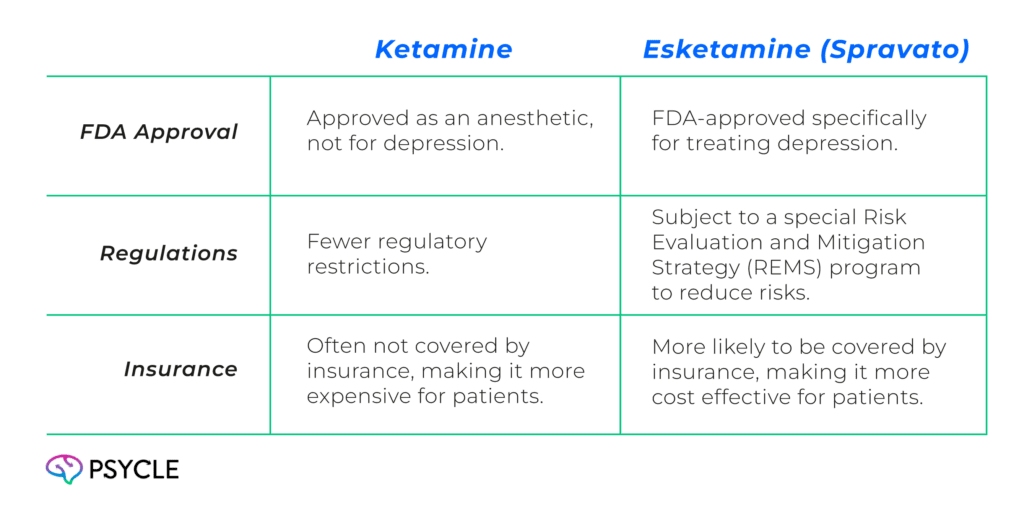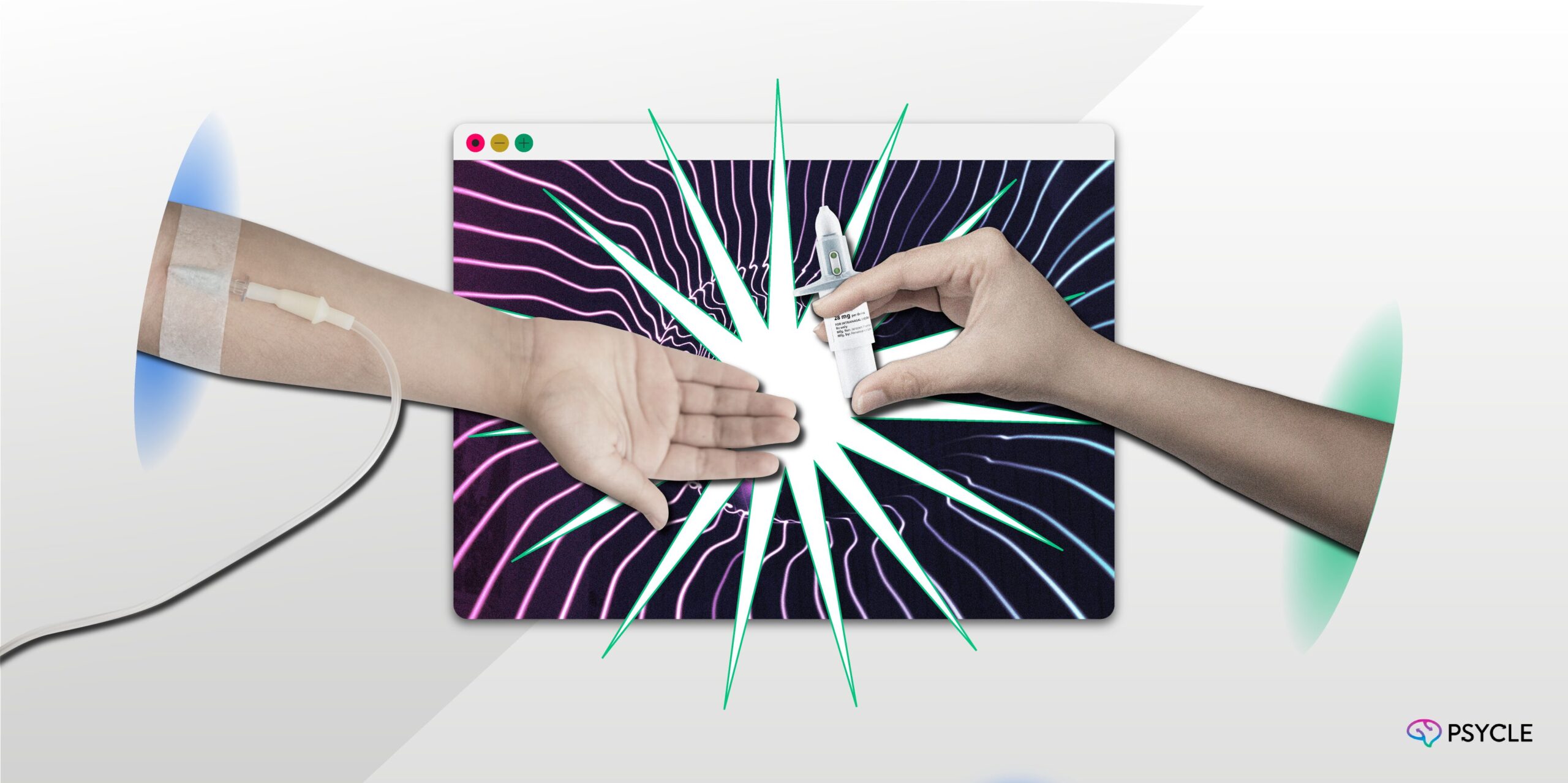Ketamine and Spravato (esketamine) have recently emerged as novel treatments for depression, showing fast and sustained results for treatment-resistant patients. This article will explore the differences between these two treatments, covering their effectiveness, side effects, and practical considerations like cost and administration.
Whether you’re exploring these options for yourself or a loved one, this guide will help you decide which treatment might be better for managing TRD.
Key Takeaways
- Both ketamine and Spravato are effective for treatment-resistant depression, with ketamine showing faster results, but studies suggest similar overall outcomes.
- Ketamine is given via IV infusion, while Spravato is a nasal spray. Spravato is FDA-approved and more likely covered by insurance.
- Both have similar side effects like dizziness and nausea, but ketamine may cause more intense psychoactive effects, while Spravato’s side effects are more predictable.
Treatment-Resistant Depression: Prevalence and Impact
Major depressive disorder (MDD) affects millions globally, with rates continuing to rise. Standard treatment typically involves talk therapy and antidepressants, such as selective serotonin reuptake inhibitors (SSRIs) like fluoxetine (Prozac), citalopram (Cipramil), and escitalopram (Cipralex).
However, around 30-40% of people with depression do not respond to these treatments, known as treatment-resistant depression (TRD). The FDA defines TRD as a “failure to respond to two or more antidepressant regimens despite adequate dose and duration and adherence to treatment.”
TRD significantly impacts both individuals and society, contributing to emotional distress and substantial economic costs. TRD cost the US healthcare system an estimated $43.8 billion in 2019.
Ketamine: A Breakthrough in Depression Treatment
Ketamine was originally developed as an anesthetic but has gained recognition as a potent antidepressant over the past decade. In the year 2000, researchers conducted the first randomized controlled trial showing ketamine had fast-acting and sustained benefits for patients with depression. Since then, multiple studies have highlighted ketamine’s powerful antidepressant effects, including for those with TRD.
Ketamine differs from traditional antidepressants like SSRIs through its unique interaction with NMDA receptors (more below). While SSRIs can take weeks to show effects, ketamine can reduce symptoms in hours, making it a promising option for those with severe depressive symptoms, such as suicidality. Moreover, whereas conventional antidepressants are taken every day, the antidepressant benefits of ketamine can last from several days to weeks.
Esketamine (Spravato): A Practical Alternative to Ketamine
Esketamine is the S-enantiomer of ketamine, meaning it is one of two mirror-image molecules that make up ketamine. It is more potent than R-ketamine (the other enantiomer) in blocking NMDA receptors (more below). This allows for smaller doses to be used, supposedly decreasing the risk of side effects.
Johnson & Johnson’s Janssen Pharmaceuticals developed Spravato, which is esketamine as an intranasal spray, around 2010. Spravato was approved as a licensed treatment for depression by the FDA in 2019.
Dosing and Administration
Ketamine Infusion
The dosing for a ketamine infusion typically begins with a starting dose of 0.5 mg/kg, which is administered over 40 minutes. Doses may be adjusted incrementally based on the patient’s response and tolerability, with some protocols increasing the dose by 0.1 mg/kg as needed.
The number of sessions required during the ketamine infusion process will vary depending on the person. Ketamine infusions may be given as a standalone or a course of treatment. Patients receiving ketamine infusions for TRD typically receive around six doses over several weeks.
Ketamine is most commonly administered intravenously, injected into a patient’s veins to reach the bloodstream and have an instantaneous effect. This administration occurs in a closely monitored clinical setting so that healthcare providers can monitor vital signs such as blood pressure and heart rate during infusions.
Esketamine
Spravato is a nasal spray device that typically contains two doses. The starting dose for adults with TRD is generally around 56 mg. However, like ketamine infusions, the doses may be adjusted based on the patient’s response.
Spravato is usually taken twice a week for four weeks, and after this initial period, the dose may be reduced to once a week. Spravato is also taken under a doctor’s supervision at a medical facility so patients can be monitored for side effects.
Mechanism of Action
Both ketamine and Spravato block NMDA receptors in the brain, which respond to the neurotransmitter glutamate. Through blocking inhibitory NMDA-mediated pathways, ketamine can increase glutamate release. This, in turn, may activate brain networks associated with mood regulation.
Both drugs increase the amount of BDNF (brain-derived neurotrophic factor) through their action at NMDA receptors. BDNF supports the survival and growth of nerve cells, potentially helping repair damaged neural circuits.
Esketamine binds more strongly to NMDA receptors than ketamine, and hence, lower doses are required to produce an antidepressant effect.
Comparing Ketamine and Spravato: Efficacy and Safety Considerations

Efficacy
In an observational study from Cambridge University, researchers compared the outcomes of TRD patients who had either Spravato or intravenous ketamine. Those with intravenous injections had slightly better symptom improvements and higher remission rates. However, there was no significant difference between the two.
Another study from Yale University directly compared reductions in depressive symptoms between ketamine infusion and Spravato. Remission rates and overall reduction in depression scores were similar between the two groups. However, secondary outcomes, including the patient’s quality of life, were higher for the infusion group.
Safety
Ketamine and Spravato share the same side effects, including dizziness, nausea, dissociation, increased heart rate, and blood pressure. Both ketamine and esketamine also carry a risk for substance abuse, given the desirable psychoactive effects of the drug and the build-up of tolerance that occurs with repeated high doses.
Side effects specific to ketamine infusions include injection site pain, and generally, the psychoactive effects tend to be more intense as a higher dose is used. Esketamine may cause nasal blockage and discomfort.
Spravato doses tend to be more controlled than ketamine infusions, so side effects may be more predictable and can be better managed. However, there is very little data directly comparing the side effect profile of the two treatments.
In one study review, more patients dropped out of esketamine trials because of adverse effects compared to patients who received ketamine infusion. In another study review, the researchers concluded that ketamine infusions, but not Spravato, have a risk for impaired cognitive function.
Patient Perspectives
The preference between intravenous ketamine and esketamine will be completely dependent on the patient.
If patients are scared of needles, they may have a preference for using Spravato rather than intravenous ketamine. However, if they are looking for a more rapid relief, intravenous ketamine could be a better option.
Forum site users often describe ketamine to be a more intense experience than esketamine. So, for those curious about their mind and exploring consciousness, intravenous ketamine could be a preferable option.
Want to try ketamine therapy? Head over to BetterU and get $50 off with Psycle50 at checkout.

Regulatory and Legal Considerations
Both ketamine and esketamine Schedule 3 compounds, defined as having low potential for physical and psychological dependence.
The FDA approves Spravato for treating depression, but ketamine has only been approved as an anaesthetic. This means ketamine is used “off-label” in depression treatment and has less stringent rules surrounding its use. Spravato, on the other hand, has a special program called the Risk Evaluation and Mitigation Strategy (REMS) which helps lower the risks of sedation, breathing problems, and misuse.
Spravato’s approval also means that, unlike ketamine infusions, it can often be covered by insurance, making it more cost-effective for patients.
Spravato vs Ketamine Infusion: Which is Better?
Spravato (esketamine) and ketamine are promising for treating depression, especially for those who haven’t found relief with other treatments. Intravenous racemic ketamine has shown better results in some studies. Yet, Spravato is easier to use and might have fewer psychological effects.
Choosing between Spravato and ketamine should be a team effort with a healthcare provider. They will consider what’s best for you, your preferences, and your health. More research is needed to fully understand how these treatments compare safety and long-term effects.
FAQs
How Does Ketamine Work to Treat Depression?
Ketamine treats depression by blocking NMDA receptors in the brain. This can increase the release of glutamate and pathways involved in neuroplasticity, the ability for the brain to re-organize. This could potentially repair neural circuits involved in depression and improve mood.
What are the Main Differences Between Ketamine and Spravato (Esketamine) in Terms of Administration?
Ketamine is typically administered intravenously in a clinical setting, while Spravato is a nasal spray that is also given under medical supervision but does not require needles.
Are the Side Effects of Ketamine and Spravato Similar?
Yes, both treatments can cause side effects like dizziness, nausea, and dissociation. Ketamine infusions may result in more intense psychoactive effects, while Spravato’s side effects are generally more predictable. There are also specific side effects related to the administration method, such as needle pain from ketamine infusions and nasal discomfort from Spravato.
Is Spravato Covered by Insurance?
Spravato is FDA-approved for treating depression, making it more likely to be covered by insurance, unlike ketamine, which is often used off-label and may not be covered. Top medical insurance companies, including Cigna, Aetna, BCBS, United Healthcare, and Medicaid, all cover Spravato costs.

